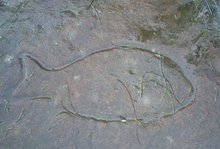 The Spotted Wobbegong (Orectolobus maculatus) is a shark that lives in temperate to tropical rocky reefs. It likes to rest in caves during the day and at night it inhabits the bottom of the shores. Occasionally it ventures offshore. Sea grass beds are the preferred nursery. It has nice spots and a substantial 'beard'. If all is well, it can become 100 years old and measure up to three metres.
The Spotted Wobbegong (Orectolobus maculatus) is a shark that lives in temperate to tropical rocky reefs. It likes to rest in caves during the day and at night it inhabits the bottom of the shores. Occasionally it ventures offshore. Sea grass beds are the preferred nursery. It has nice spots and a substantial 'beard'. If all is well, it can become 100 years old and measure up to three metres.
But there is a hitch, which is that the majority of Australians live along this very coast-line. The interface of shark habitat and the human field of activities has led to the near eradication of this species.
Extractive practices are seeking to plunder or commericalise every bit of the creature:
Commercial fishing with a high rate of by-kill extracted many, sometimes chucking them if there was no market for them. “Recreational”, sports-fishing competitions and spearfishing do the rest.
 All is well, now that the remaining wobbegongs in the 'wild' are tagged with radio transmitters and seven were bred in captivity, then also tagged and released into Shelly Beach Reserve. ”...Acoustic study and tracking devices will ensure that we can find much more about it.” Fitting electronic devices onto or into juvenile creatures usually employs invasive methods, as the gear is glued on with epoxy resin or suction pads. The ethics of this practice is questionable. Data-gathering from the dry comfort of the screen and DNA mapping might just reveal that the object turned into flake or by-kill yet again. Managing the mind-sets and practices of their own kind might ensure a sustainable habitat and an effective biodiversity management.
All is well, now that the remaining wobbegongs in the 'wild' are tagged with radio transmitters and seven were bred in captivity, then also tagged and released into Shelly Beach Reserve. ”...Acoustic study and tracking devices will ensure that we can find much more about it.” Fitting electronic devices onto or into juvenile creatures usually employs invasive methods, as the gear is glued on with epoxy resin or suction pads. The ethics of this practice is questionable. Data-gathering from the dry comfort of the screen and DNA mapping might just reveal that the object turned into flake or by-kill yet again. Managing the mind-sets and practices of their own kind might ensure a sustainable habitat and an effective biodiversity management.Large boats throw their heavy anchors into this delicate aquatic reserve. The noise and chemical pollution they cause is not compatible with a reserve for 'wildlife'. Suburbs drain their effluent into the shores and at night keen divers disturb creatures in their habitats with bright torches.
Just yesterday there were, yet again people line fishing IN the Cabbage Tree Bay Aquatic Reserve. Spearfishing in it has also been reported.
Links:
Spotted Wobbegong, IUCN Programme
Cabbage Tree Bay Aquatic Reserve, Shelly Beach, Manly
NSW AMSA Position Statement on Marine Protected Areas and No-take Marine Sanctuaries, 2008, pdf
Australian shark fishing out of control ,The Nature Conservation Council?
The cost of Recreational Fishing and Boating on the Moreton Bay Marine Park, Bay Journal
Marine, National Parks Association of NSW, advocating the establishment of marine sanctuaries in NSW, only 6.5 % of NSW marine habitat is protected.











No comments:
Post a Comment